Cotton with broderie anglaise trimming
Labelled ‘Mary Quant’
Lent by Fashion Museum Bath / Gift of Mary Quant
Photo: Michelle Guo
Mary Quant: Fashion Revolutionary
Michelle Guo
Mary Quant’s London was the final exhibition to be staged by the London Museum at Kensington Palace between November 1973 and September 1974. The Quant retrospective represented a last hurrah and the first step towards modernising the museum, which had previously only exhibited historical costume. (The London Museum subsequently merged with the Guildhall Museum, moved to the Barbican complex and was rebranded as the Museum of London.) It was touted as the “first major museum exhibition to explore the work of a single, living fashion designer” and “only the second museum exhibition in London ever to be devoted to contemporary fashion”.
Mary Quant’s name is inextricably synonymous with the 60s and mod fashion—a fact that led to her immense but temporally-bound cultural influence. The brand was still active when London Museum staged their retrospective, prompting the New York Times headline ‘Already, a Mary Quant Retrospective’.
From the very start of the Sixties I could see myself at 75 on television telling people about that time. It was the time of my time. I will never have so much fun again, ever.
– Michael Caine
By then, however, it had already become increasingly apparent that the exuberance of the sixties was a fantasy that the youth who basked in it needed to grow out of. Before the decade was even over, fashion photographer David Bailey and journalist Peter Evans published a photobook eulogising the Swinging Sixties, Goodbye and Amen: A Saraband for the Sixties.
This immediate instinct to mythologise and memorialise a decade that was not yet over suggests an awareness of the fragility of the fantasy of freedom and relentless turnover of styles it had created, and an inclination to create cultural artefacts that facilitated a nostalgic reminiscence of the decade.
While covering the same subject matter using very similar approaches, Mary Quant’s London and Mary Quant: Fashion Revolutionary do strike somewhat of a tonal divergence due to their different temporal relationships to their subject matter. Both exhibitions explore Quant’s illustrious career, beginning with the opening of her boutique Bazaar in 1955 to her later inextricable connection to the graphic identity of the sixties and the entrepreneurial success that came with it.
Mary Quant’s London was part of this mythmaking and memorialisation, closing the page on the raucous decade.
Fifty years later, Mary Quant: Fashion Revolutionary has given us enough distance for uncritical nostalgia to kick in. Originally conceptualised by the V&A museum, the exhibition subsequently travelled to V&A Dundee before heading to Bendigo Art Gallery, V&A’s Australian hub for its touring exhibitions.
Quotes and statements made by Quant and her contemporaries decorate the walls of the exhibit in huge, bold lettering. The V&A, and subsequently Bendigo Art Gallery use the following quote from fashion journalist Ernestine Carter as the raison d’être for another Mary Quant retrospective:
“It is given to a fortunate few to be born at the right time, in the right place, with the right talents. In recent fashion there are three: Chanel, Dior and Mary Quant.
Today, juxtaposing Chanel, Dior and Quant is a strange proposition. While Chanel and Dior do have their significant designs and moments, they are associated with the reinvention of existing textiles (tweed), and silhouettes (New Look) and possess a certain timelessness about them.
Part of this comes from the continued self-referencing of these design elements even after the eponymous designers were no longer in charge of their respective labels. Recent Chanel and Dior fashion collections largely consist of an amalgamation of references to their past collections, as if reminding the public that their illustrious past sufficiently justifies their continued existence. It is a ham-fisted approach that has led to many lacklustre collections and few attempts to push fashion forward. But it is a strategy that has worked; Chanel and Dior are still prominent names in the fashion industry today.
Mary Quant, on the other hand, operates on a much smaller scale, primarily targeting the Japanese market and capitalising on retro-nostalgia by entirely replicating the same sixties aesthetic that it had been at the forefront of at the time. The designer herself resigned from the company in 2000 but still provides consultation for it.
Quant rejected the conventions of couture early in her career. She was one of the early adopters of the boutique store, as opposed to the atelier and department store. This shift redirected focus to the youth as the most valued fashion consumer.
In the early years of her brand, she released over twenty-eight different collections. These are unsurprising figures in today’s fashion ecosystem, rife with fast fashion and fashion week calendars packed with resort, apres-ski and pre-fall collections. Following the pandemic, many big names in the fashion industry are currently trying to pull back from such an oversaturated fashion landscape.
For Quant, though, it is easy to see how one could have been swept up in the Youthquake craze that rapidly took over the Western world.
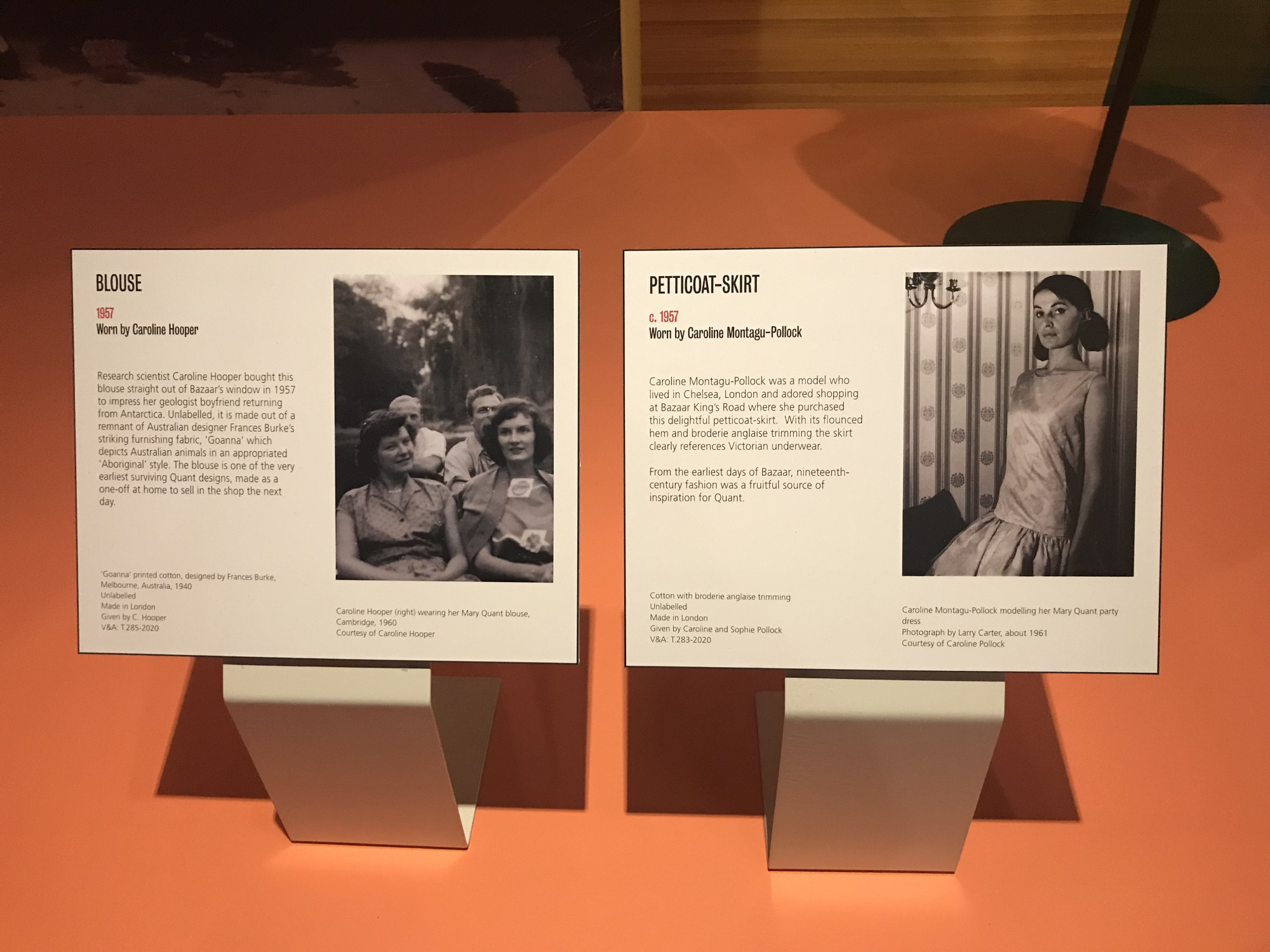
Mary Quant: Fashion Revolutionary prioritises audience engagement, taking seriously Quant’s mission to make her brand as widely accessible as possible. Prior to the exhibition, the V&A had launched a campaign to collect garments and personal stories from wearers of Mary’s radical designs, using the hashtag #WeWantQuant. Many of these garments and stories subsequently made their way into the exhibition.
While walking through the exhibition, I loved overhearing the older ladies talk about their Swinging Sixties experiences—the hairstyles they donned, the looks they rocked, the places they went.
Too often, fashion exhibitions overly focus on the macro changes and discuss a designer’s impact in terms of trends, influence and famous clientele. Editorial shoots and runway footage are in service of the designer’s vision and the people’s wildest desires, rather than their everyday sartorial needs. The public response is addressed monolithically, in service of all-too-familiar narratives and tropes (the enfant terrible, the outsider, the visionary, the artist, the genius etc.).
In Fashion Revolution, it was very refreshing to see and hear more down-to-earth stories about how ordinary people engaged with the exhibited styles.
Such encouragement and openness towards visitor input reanimated Quant’s garments against the backdrop of the museum’s stillness. Seeing signs of wear and tear on exhibited garments is uncommon in blockbuster fashion exhibitions, which rely on collectors and designer archives to fill out a space. Quant herself worked to push back against the “snobbish grip of haute couture” that such reverence signified. Felting, warped fabrics and loose threads all indicate that the garments shown were well loved and full of stories.
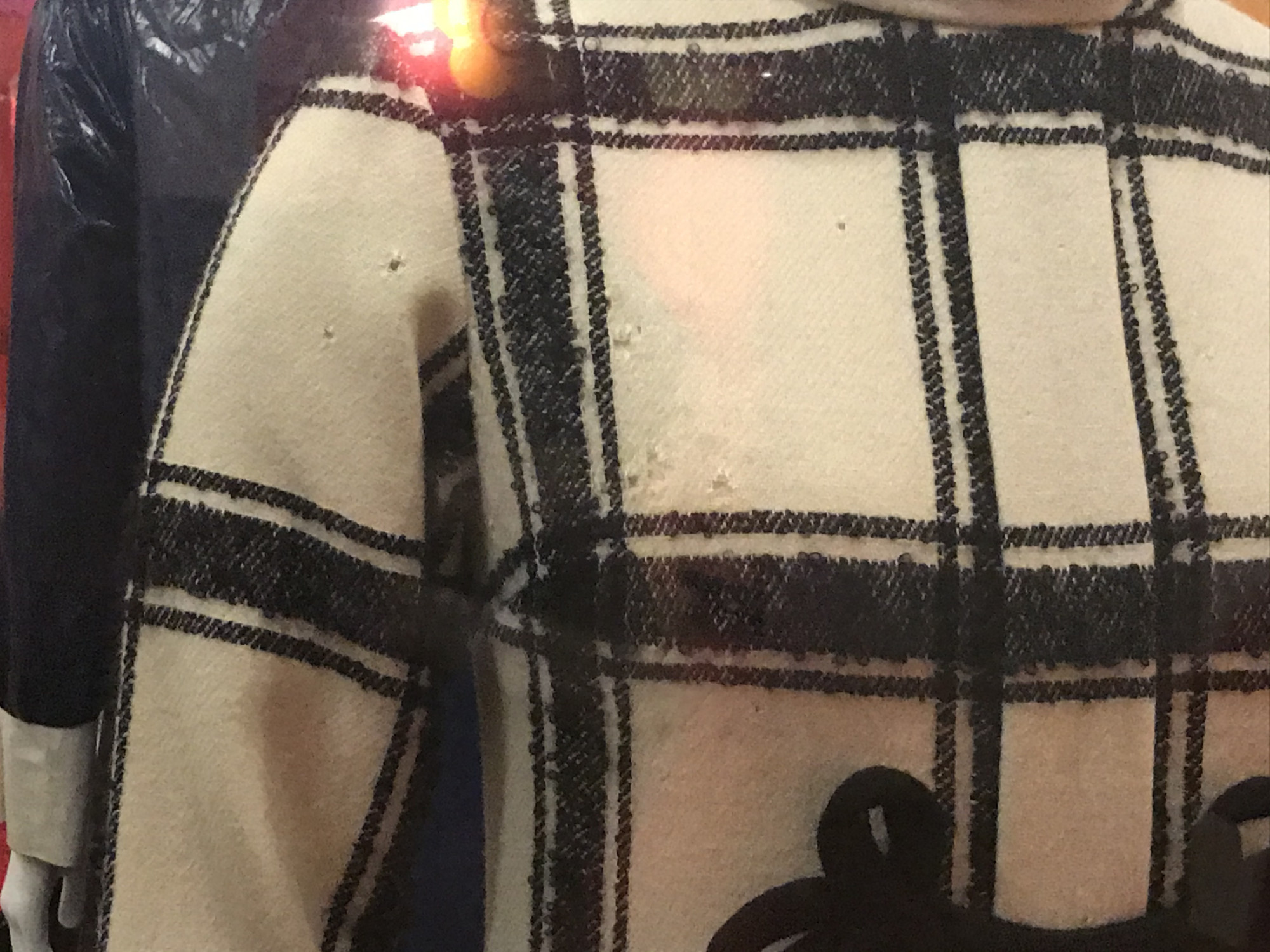
Wool tweed with silk frogging
Given by the family of the late Philip Pollock
V&A: T.286-2020
Photo: Michelle Guo
Animation and movement are an important theme in Quant’s work. The impetus behind many of her design choices was to ensure that the women who wore her clothes had access to the full spectrum of bodily freedom. Mary Quant’s Youthquake served the lively young working women who still knew how to have fun. Mary herself was one of these women.
People who were not around to experience the Swinging Sixties can still resonate with the youthfulness of Quant’s designs. There is joy and playfulness felt in Quant’s design process that is missing in fashion today. One yearns for the opportunity to experience what it was like to be in the middle of that frenetic yet carefree atmosphere.
Quant did not design for an unattainable, aspirational muse. She designed with the everyday woman’s needs in mind. One of the most engaging displays in the exhibition is of a video of one of her fashion shows, which was the total antithesis of the conventional, serious fashion runway. The models danced along to live music, goofily playing around with various props.
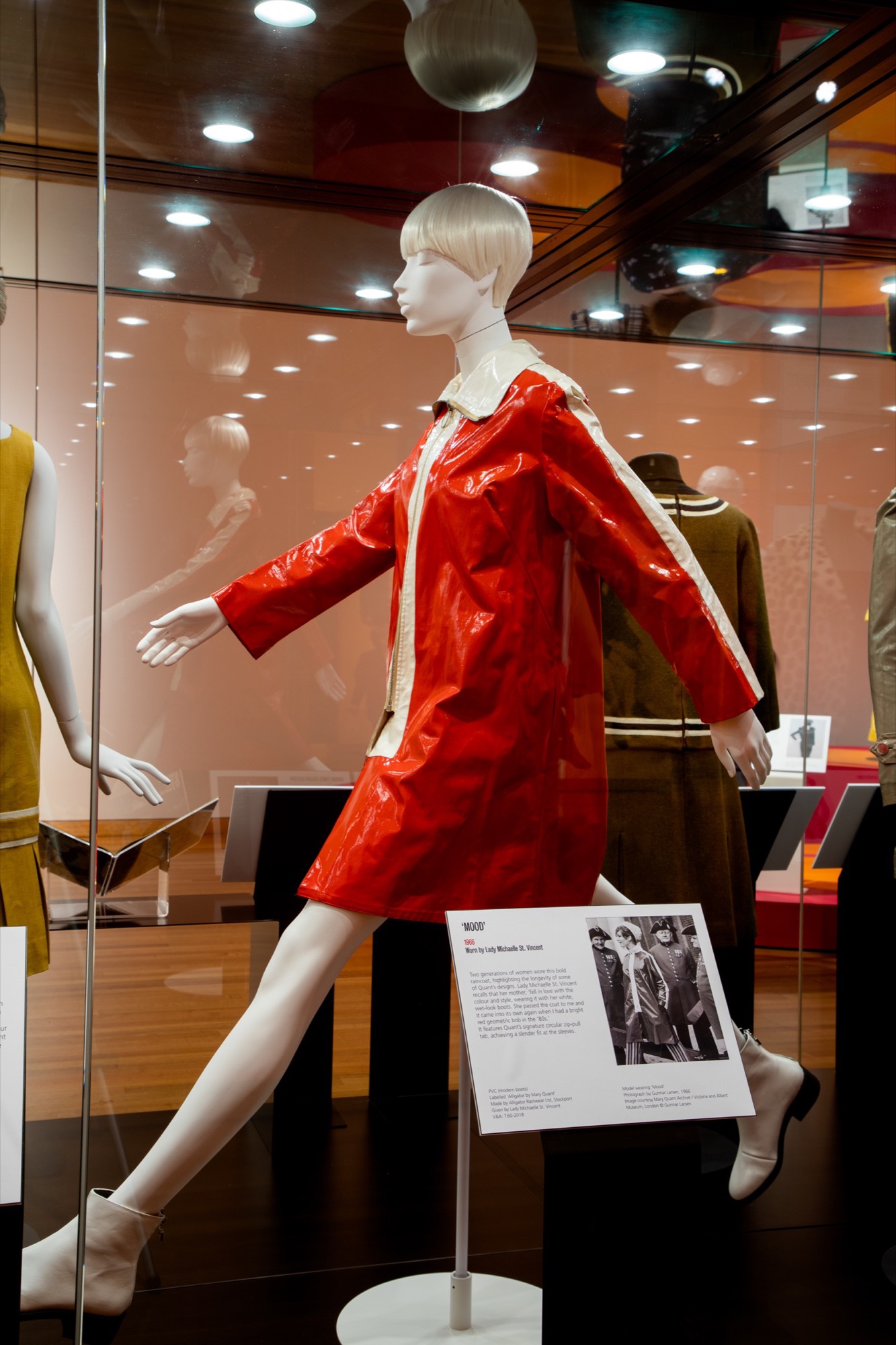
PVC (modern boots)
Given by Lady Michael St. Vincent
V&A: T.60-2018
Photo: courtesy of Bendigo Art Gallery
It is a shame that this liveliness could not be more incorporated into the exhibition; the donated garments are now likely part of the V&A’s collection and can no longer be worn. A valiant attempt was made through some dynamically posed mannequins to demonstrate ease of moment, sustaining a tension between the prestige of museum canonisation and the spirit of the garments. The museum, after all, is more like the couture collector than Quant’s young, hip working woman.
The revolutionary character of something is measured by its impact on what came after. Revolution causes a dramatic a shift from what came before. But the exhibition spends little time exploring Quant’s impact on other designers or contextualising the London that Quant made a splash in. The display acknowledges this, but the exhibition takes minimal interest in exploring Quant’s inspiration and legacy.
Quant clearly had an immense fascination with design and fashion; I would have loved to have heard more about her design process, as illustrated in the following quote:
Ideas will often come indirectly: I have strange eye that transforms twenties bathing suits into fur coats, thirties knitting patterns into dresses, Romanian embroidered socks into knickers and bras, Provençal tiles into sheets and duvets, Schiaparelli hats into trousers, paint boxes and crayon tins into cosmetics, Easter eggs into scent containers, needlepoint into jacquard, and male into female or vice versa.
The exhibition is also sure to emphasise Quant’s fascination with cutting edge textiles, such as Lycra and PVC.
Another “revolutionary” aspect touched on briefly is the association of the sixties with revolutionary social movements. The exhibition explores this only to the extent of demonstrating how Quant’s clothes were intended to be worn by the emancipated woman.

Scale-wise, the V&A has bulked out the show with almost four-times the number of objects of Mary Quant’s London. The second half of the exhibition was more interested in Quant from the perspective of branding and the building of her empire, featuring an amalgamation of garments, photos, videos, print ephemera and products from Quant’s broader licensing empire, including toys, accessories, sewing patterns and homewares.
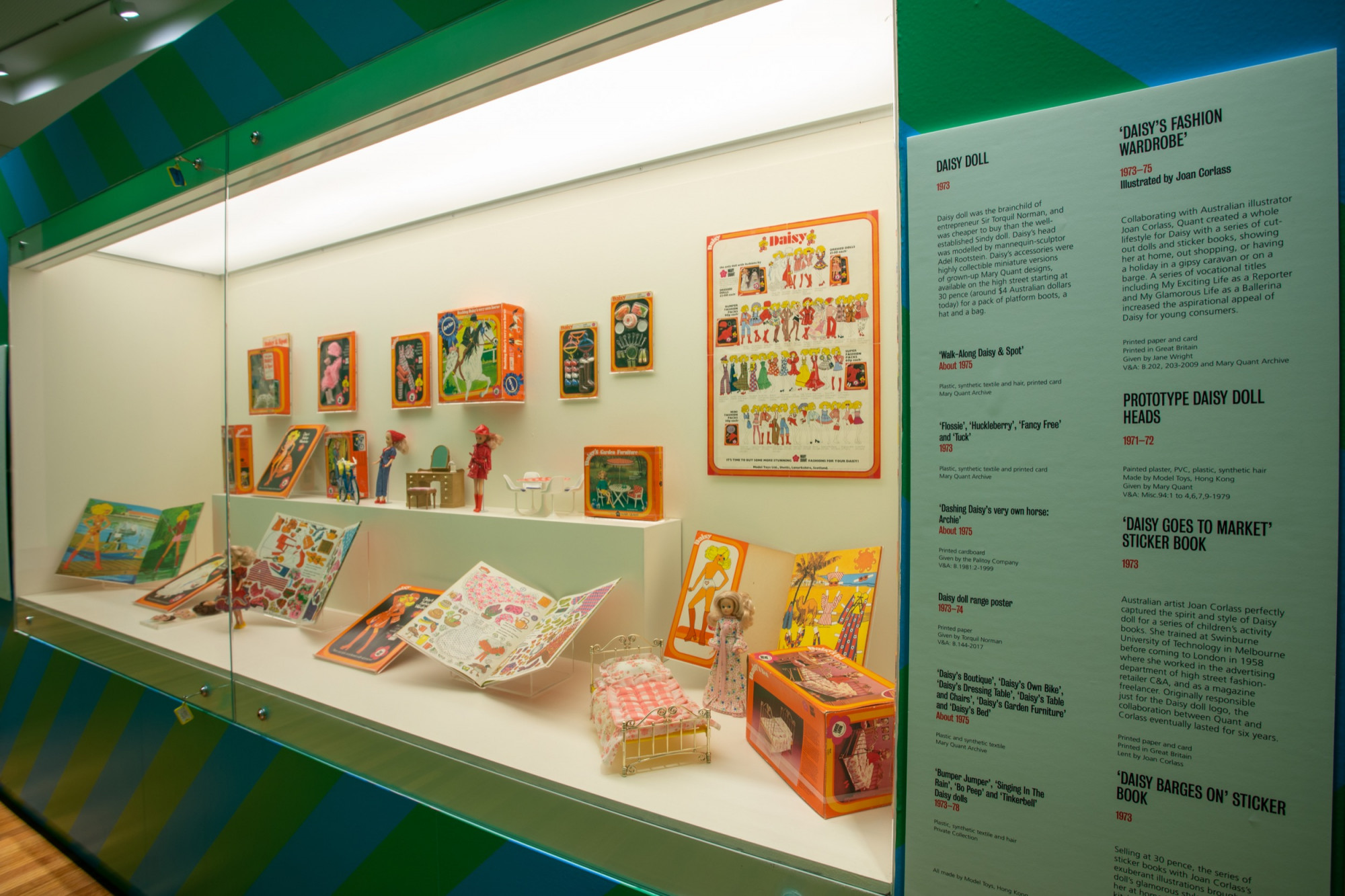
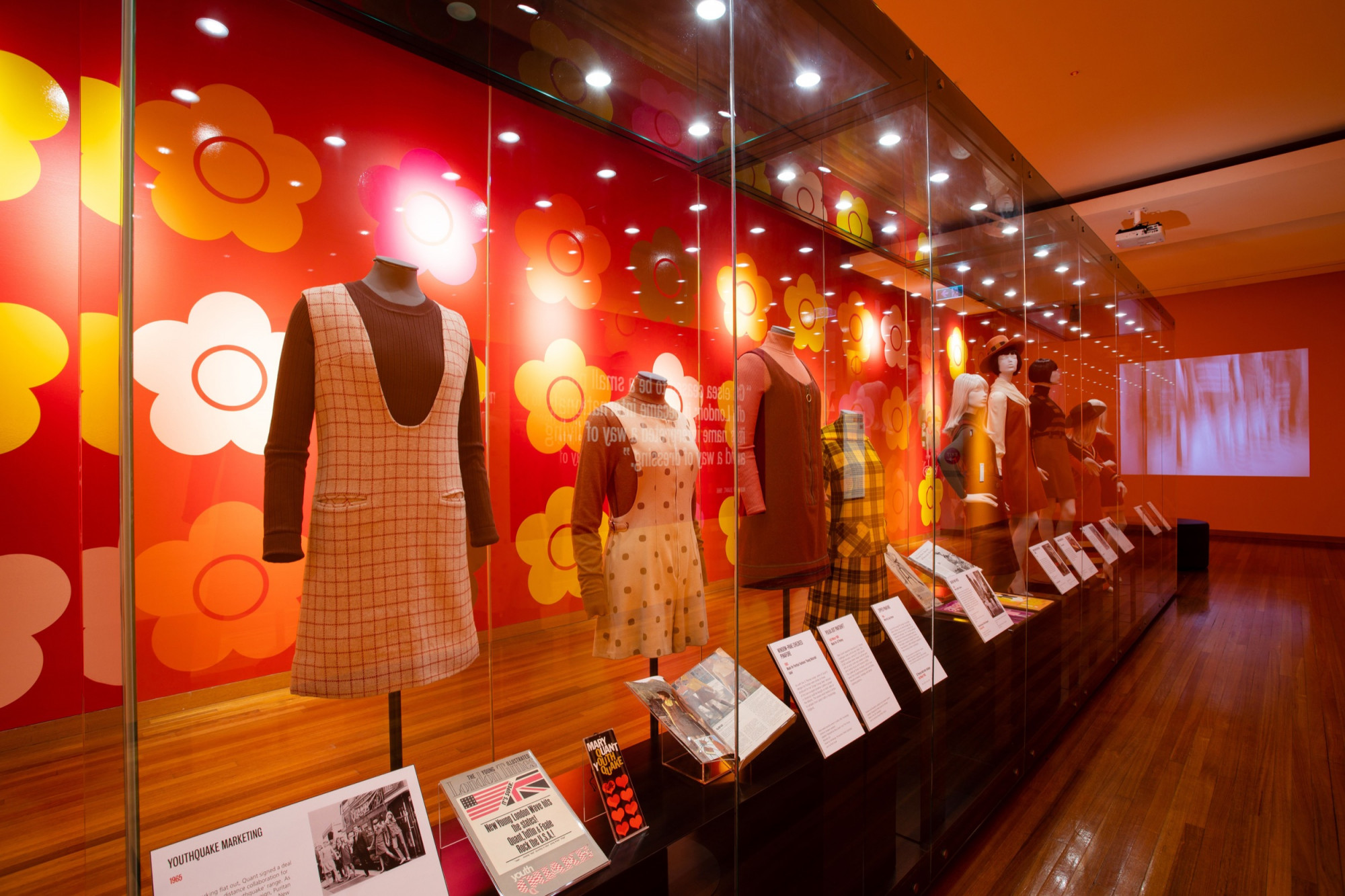
This is the revolutionary aspect of Quant’s story that the exhibition explores more deeply: Quant’s interest in democratising her brand; making it accessible to the masses was strongly felt in the sheer number of exhibited objects. Quant had created an all-encompassing aesthetic empire, premised on the idea of approachability. And as Quant became more and more involved in mass production with the formation of her more affordable collection, Ginger Group, the prices of her clothes fell.
The venture to democratise the “Mary Quant look” culminated in a collaboration with Butterick, making sewing patterns of her classic silhouettes available to be constructed at any price point by the home dressmaker. There is a lovely circularity to this collaboration, given that Quant started out selling clothes at Bazaar created from Butterick patterns she had adapted.
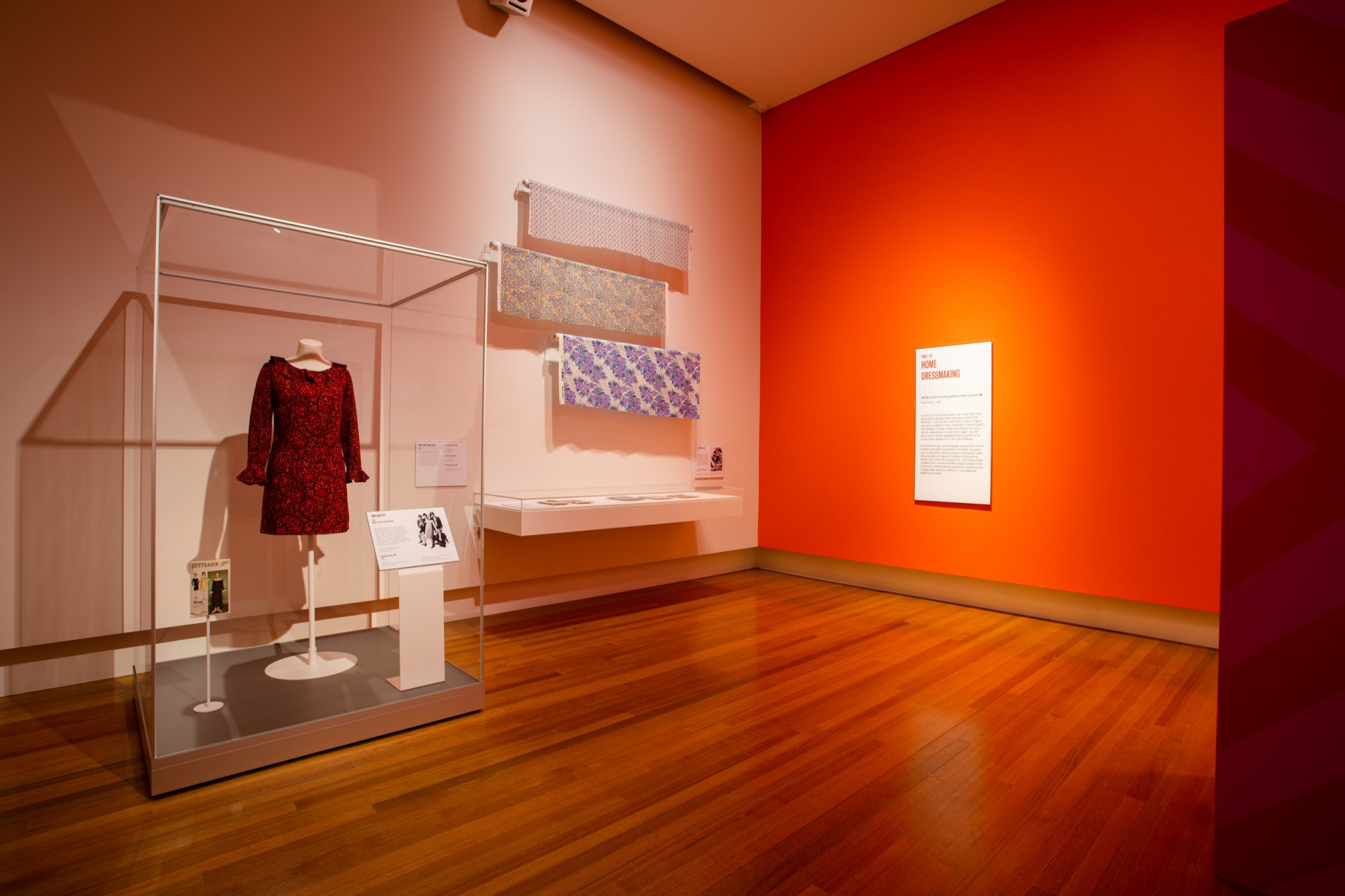
A common critique of many blockbuster fashion exhibitions is the sheer number of objects, indicative of a curatorial vision that is either undirected or entirely absent. For Mary Quant: Fashion Revolutionary, the idea of mass production and mass distribution are such important themes to her story that the abundance of objects, many of which consist of the same garment in a variety of colours, feels fitting.
Rather, the exhibition is much more interested in Quant’s revolutionary approach to manufacturing, licensing, and branding, which still impacts the fashion industry to this day—just look at the number of fashion houses who release collections of makeup, lingerie, homewares and other assorted merchandise.
At the end of the exhibition, the viewer is left to draw their own comparisons between Quant’s ventures and the fashion industry as they experience it. The exhibition concludes with exhibit after exhibit of the products of licensing deals that Mary Quant made, as if prodding to see how many of the objects they recall in the periphery of their memories.
Mary Quant: Fashion Revolutionary is the origin story of a ready-to-wear empire and aesthetic/graphic identity that became inextricably bound to a short-lived era. The exhibition replicates the escapist fantasy of the Swinging Sixties by following the fashion figurehead of the era. Perhaps it is a bit too much to ask for a fashion exhibition to explore the deeper complexities of the era. After all, fashion excels in escapism.
Michelle Guo is an emerging fashion/art curator, writer and historian. She is interested in the interactions between art and fashion with culture more broadly.